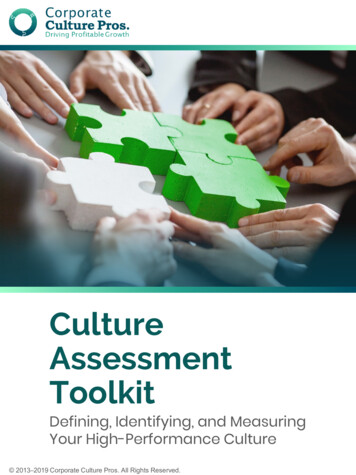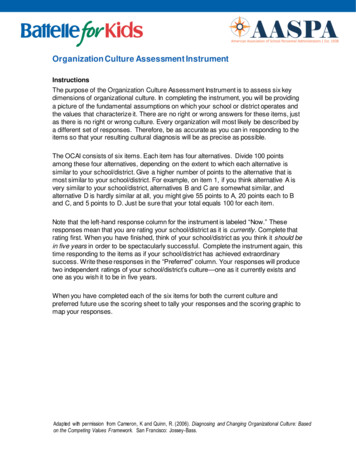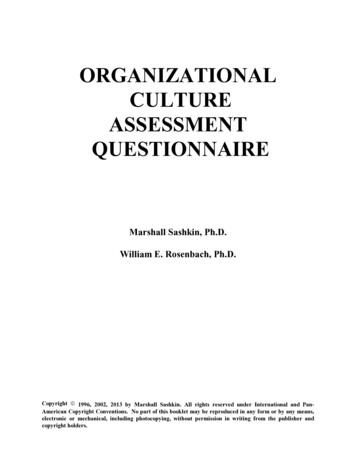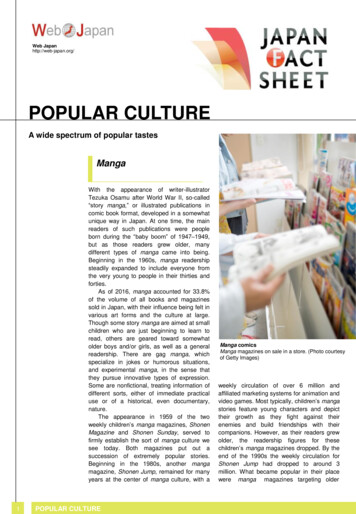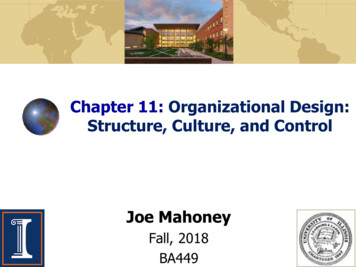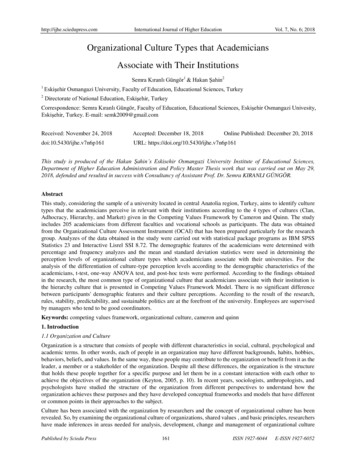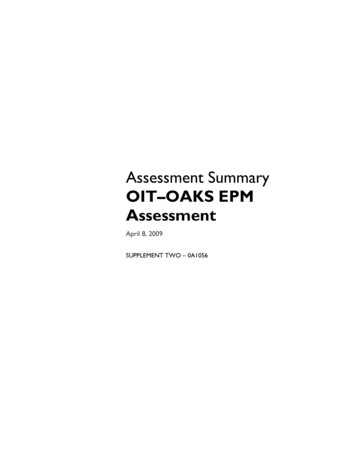
Transcription
Organizational CultureAssessment InstrumentTheory and Toolplus the OCAI online products and services
ContentsWhy work with Culture? 3The Competing Values Framework 4The Organizational Culture Types 5The OCAI Assessment 7The Culture Change Process 9OCAI online products and services 12 Marcella Bremer2 OCAI online
Why work with Culture?Why do organizations invest in organizational culture? Cultureinfluences organizational performance, innovation, agility, engagement,recruitment and retention, and competitiveness.Kotter and Heskett found that effective culture can account for 20-30percent of the differential in corporate performance when comparedwith “culturally unremarkable” competitors.Professor Kim Cameron showed that a positive climate, positive relationships, communication, and positive meaning lead to “positivedeviance” or high performance.Christine Porath and Christine Pearson did a study with 14,000respondents and found that incivility demoralizes people. The estimatedloss of productivity per year per employee is 14,000 on average. BillSutton (Stanford University) has suggested that productivity coulddecrease by 40% when workers experience bullying.Summarized: a toxic culture decreases productivity with 40%, incivilityas part of culture damages productivity with 14,000 per employee peryear, while an effective culture increases productivity with 20%, and apositive culture boosts results by 30-40%“I want to pass onmy personal thanks foryour speedy and highlyprofessional analysis ofmy surveys.”—Dr. Brian Armstrong,Culture is also often the reasonwhy 70 percent of all mergers,acquisitions and organizationalchange projects fail.Thus, culture is not as “soft”as prejudice would have it. Itproduces hard results.The Organizational CultureAcute Care, Belfast HealthAssessment Instrument (OCAI,& Social Care Trust Kim Cameron) is a validatedtool for assessing organizationalculture, developed by RobertQuinn and Kim Cameron at theUniversity of Michigan. As people are often not aware of the culture, theOCAI helps people and organizations notice their current culture andsee what they would change.Co-Director of Unscheduled &The OCAI survey is based on the Competing Values Framework: oneof the most used and useful frameworks; by over 10,000 companies in30 years (ten Have, 2003).3 OCAI online
It is well-researched and validated, but also compact with six aspectsthat reliably represent an organization’s culture. It’s a quick culturesurvey that can be done in 15-20 minutes online, in 19 differentlanguages. Let’s look at its theory first.The Competing Values FrameworkThe Competing Values Framework (CVF) emerged from research toidentify the organizational effectiveness criteria (Quinn & Rohrbaugh,1981). The criteria that were found to make a difference are thedimensions internal-external, and stability-flexibility.An organization might have an internal orientation; focusing inwardon development, collaboration, integration of activities, coordination.Or it might have an external orientation; looking at the market, what’spossible with the latest technology, what competitors are doing, whatcustomers want, and it could diversify activities as a result.Both internal and external attention is needed to be successful inthe long run - but depending on their environment an organizationwill have a dominant preference. An agile, volatile market calls for anexternal orientation whereas a stable environment allows an internalfocus.Note the “competing” nature of the values: you have to choose whetheryou look inside or outside - you cannot do both at the same time.The second defining dimension is the focus on stability or flexibility —organizations that prefer to organize for stability value clear structures,planning, budgets, and reliability. They assume that reality can beknown and controlled. Organizations that organize with flexibilityassume the opposite: you can never predict and control everything.They prefer a flexible attitude and organization to adapt quickly tochanging circumstances - focusing more on people and activities thanon structure, procedures, and plans.The “competing values” nature of stability and flexibility prevents youfrom doing both at the same time. Organizations can spend theirmoney, attention, and time only once, so they tend to emphasize certainvalues. Quinn and Cameron found that flexible organizations are mosteffective, which sometimes leads to contradictory behavior. The “best”organizations use all four value sets when necessary.A culture type works best in the activities domain that aligns with itsvalues. In the health care sector, for instance, we often see Collaborateor Clan culture.4 OCAI online
Beware: there is no ultimate “best” organizational culture prescribedby the Competing Values Framework. The model is descriptive - notnormative. In a specific domain or market, one culture type might fitbetter than another, and this is for the organization to decide. “Whenwould be at our best?”When you map those two polarities in a 2x2 matrix, you see fourculture types emerge:CVFInternal orientationExternal orientationFlexibilityCollaborate or Clan CultureCreate or Adhocracy CultureStabilityControl or Hierarchy CultureCompete or Market CultureThe Competing Values Framework is validated by a lot of research(Denison, 1990; Howard, 1998; Deshpande & Farley, 2004). It isaligned with other dimensions that describe how people behave whenorganizing (Linnenluecke, 2010; Ralston, Tong, Terpstra, Wang &Egri, 2006; Cameron & Quinn, 2006).These underlying dimensions of organizing exist in all human andorganizational activity. It aligns with the four biological determineddrives in the brain: the need to bond, to learn, to acquire, and to defend.(Paul Lawrence, Nitin Nohria, 2002).“The usefulnessof the OCAI and theease with which ourclients can understandthe data makes this aperfect instrument touse. The vendor is superresponsive. I love usingthis instrument andappreciate all the carewe are given.”The CVF and OCAI can alsobe related to the “Big Five”personality traits, the MBTI,and the four psychological typesdiscovered by Carl Gustav Jung.Because of this conceptual “archetypical” basis, the CompetingValues Framework can integratemany other tools on leadershipand change.This scientific basis is excellent—Judith Schechtman, Seniorbut what is best is its practicalConsultant, Triangle Associates,applicability. The CVF helpsUSAyou see what people value andemphasize when they organizeactivities, whether they are in afor-profit organization, a sportsclub, local community, or a family. The framework shows where youare and where you’d like to go.5 OCAI online
The Organizational Culture TypesMapping those two dimensions of “competing values” you get fourculture types: the dynamic, entrepreneurial Create Culture, the people-oriented, friendly Collaborate Culture, the process-oriented,structured Control Culture and the results-oriented, competitiveCompete Culture. Also known as Adhocracy, Clan, Hierarchy andMarket culture (Cameron & Quinn).Create Culture (Adhocracy Culture)This is a dynamic and creative working environment. Employees takerisks. Leaders are seen as innovators and risk takers. Experimentsand innovation are a way of bonding. Prominence is emphasized. Thelong-term goal is to grow and create new resources. The availability ofnew products or services is seen as a success. The organization promotesindividual initiative and freedom. Do new things: create, innovate, envision the futureTransformational ChangeHandle discontinuity, change, and riskFreedom of thought and action, rule-breakingThoughtful experimentation, learning from mistakes, failing fastRoles like entrepreneurs and visionariesVisionaries inclined toward risk, not afraid of uncertaintyTypical in sectors like technical start-ups, technology-driven industries(communications, sustainability), but also disruptive services likeAirbnb, Uber.Collaborate Culture (Clan Culture)This working environment is friendly. People have a lot in common,and it feels like a large family. The leaders are seen as mentors or maybeeven father figures. The organization is held together by loyalty andtradition.There is great involvement.They emphasize long-term HumanResource Development. Success is defined within the framework ofaddressing the needs of the clients and caring for the people. The organization promotes teamwork, participation, and consensus. Do things together: build teams, people matterLong-term ChangeCommitment, empowerment, cohesion, engagementHuman developmentCollective wisdom, long-lasting partnerships, and relationshipsRoles like a mentor and a coachWary of conflict6 OCAI online
Typical in sectors like health care, education, some governmentagencies, not-for-profits.Control Culture (Hierarchy Culture)This is a formalized and structured workplace. Procedures directwhat people do. Leaders are proud of efficiency-based coordinationand organization. Keeping the organization functioning smoothly ismost crucial. Formal rules and policies keep the organization together.The long-term goals are stability and results, paired with efficient andsmooth execution of tasks. Reliable delivery, continuous planning, andlow cost define success. Personnel management has to guarantee workand predictability. Do things right: eliminate errorsIncremental ChangeAttention to details, careful decisions, precise analysisIncrease consistency and reliability, well-informed expertsBetter processes and efficiency, routinesRoles like organizers and administratorsConservative, cautious, logical problem solversTypical in sectors like medicine, nuclear power, military, government,banking and insurance, transportation.Compete Culture (Market Culture)This is a results-based workplace that emphasizes targets, deadlines,and getting things done. People are competitive and focused on goals.Leaders are hard drivers, producers, and rivals. They can be tough withhigh expectations. The emphasis on winning keeps the organizationtogether. Reputation and success are the most important. Long-termfocus is on rival activities and reaching goals. Market dominance,achieving your goals, and great metrics are the definitions of success.Competitive prices and market leadership are important. The organizational style is based on competition. Do things fast: compete, move fast, play to winFast ChangeCustomer satisfaction, attack competitors, shareholder valueSpeed: results-right-now, getting things done, achieving goalsAcquire other firms, outsource selected processes,Deliver results, make fast decisions, solve problemsLeaders are hard-driving, directive, commanding, demandingTypical of sectors like consultancy, accountancy, sales and marketing,services, manufacturing.7 OCAI online
The OCAI AssessmentThe OCAI ( Kim Cameron) was carefully designed, tested, andvalidated. Respondents are asked to score six aspects of culture:1.2.3.4.5.6.Dominant characteristicsOrganizational leadershipManagement of employeesOrganization glueStrategic emphasesCriteria of success“A huge thankyou to OCAI onlinefor managing anddelivering our culturereports against theodds! Your support andinsight were extremelyFor each aspect, they must divide100 points over four statements.They assign the most points tothe statement that is most true,and the least or none to thestatement that doesn’t fit withtheir organization.The first round of scoring thevaluable”.six aspects yields a profile ofthe current culture. Quinn—Johan de Goede, consultant,and Cameron found that mostThe Human Route, South-Africaorganizations have developeda dominant culture style. Anorganization rarely has only oneculture type. Often, the cultureprofile is a mix of the four organizational culture types.The second round focuses on the preferred organizational culture inthe future. The gap between these two profiles shows the desire for anddirection of change.This way of scoring is deliberately designed. By dividing 100 pointsover four statements, respondents have to weigh and choose in theCompeting Values Framework. In reality, you can’t have everythingmaximized at the same time. A Likert-scale would allow people togive all statements a 1 or a 5 - while this way of weighing points ismore realistic.The six aspects are based on extensive research. Adding more variablesdoes not enhance the survey’s validity. Hence, the survey is short andsweet while it yields a valid representation of culture. (If you wantto know more about validity and reliability, please see the book byCameron & Quinn: Diagnosing and Changing OrganizationalCulture).8 OCAI online
By averaging all OCAI profiles, we can calculate a collective team ororganization profile to get an overview of current and preferred culture.It’s insightful to compare the culture profiles of departments, locations,levels, or professions within one organization.In smaller teams, you may have time also to compare the individualprofiles.Your OCAI culture profile shows: The dominant current cultureThe discrepancy between the present (fuchsia area) and preferredculture (blue)The strength of the current cultureThe strength of the preferred cultureThe proposed change: in what direction?People’s current “pain” and the “gain” of change in the desireddirectionThe results report also shows the congruency of the six culture aspects.Are they aligned or not? If the six culture aspects emphasize differentvalues, people may be confused, frustrated, and conflicts could ensue.Cultural incongruence often leads to a desire to change, becausedifferent values in different areas c
The Organizational Culture Types Mapping those two dimensions of “competing values” you get four culture types: the dynamic, entrepreneurial Create Culture, the peo-ple-oriented, friendly Collaborate Culture, the process-oriented, structured Control Culture and the results-oriented, competitive Compete Culture. Also known as Adhocracy, Clan .

